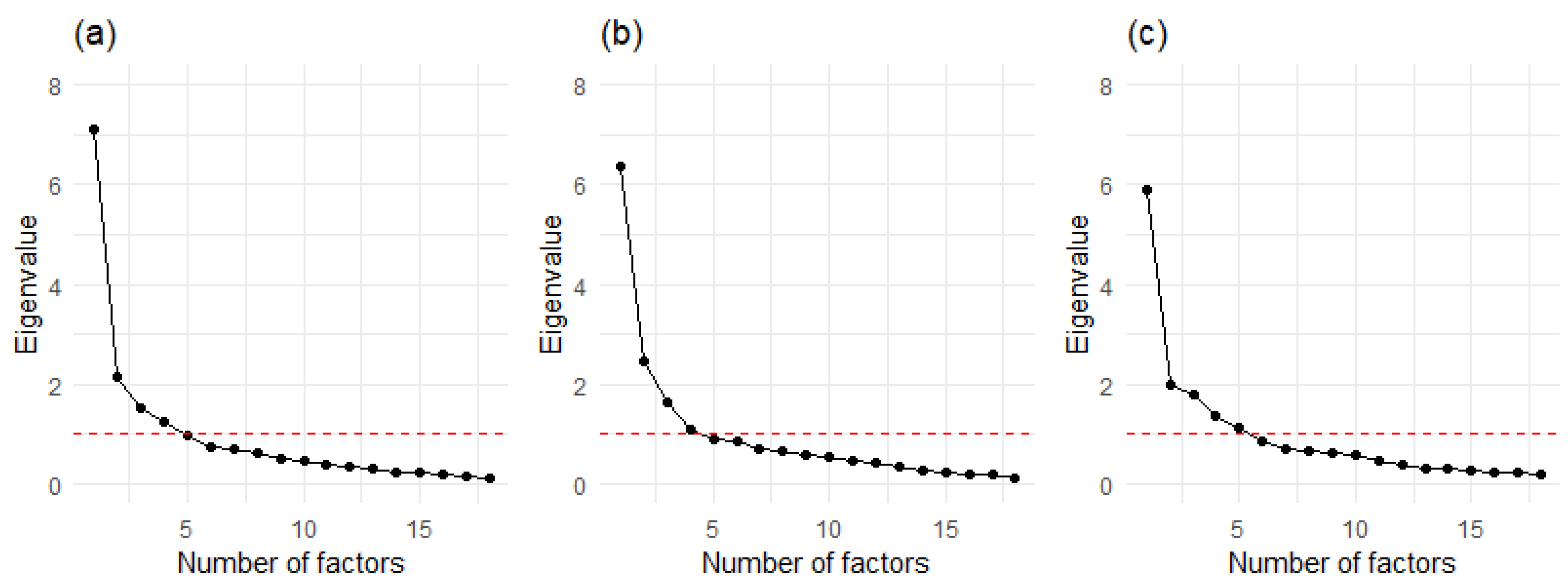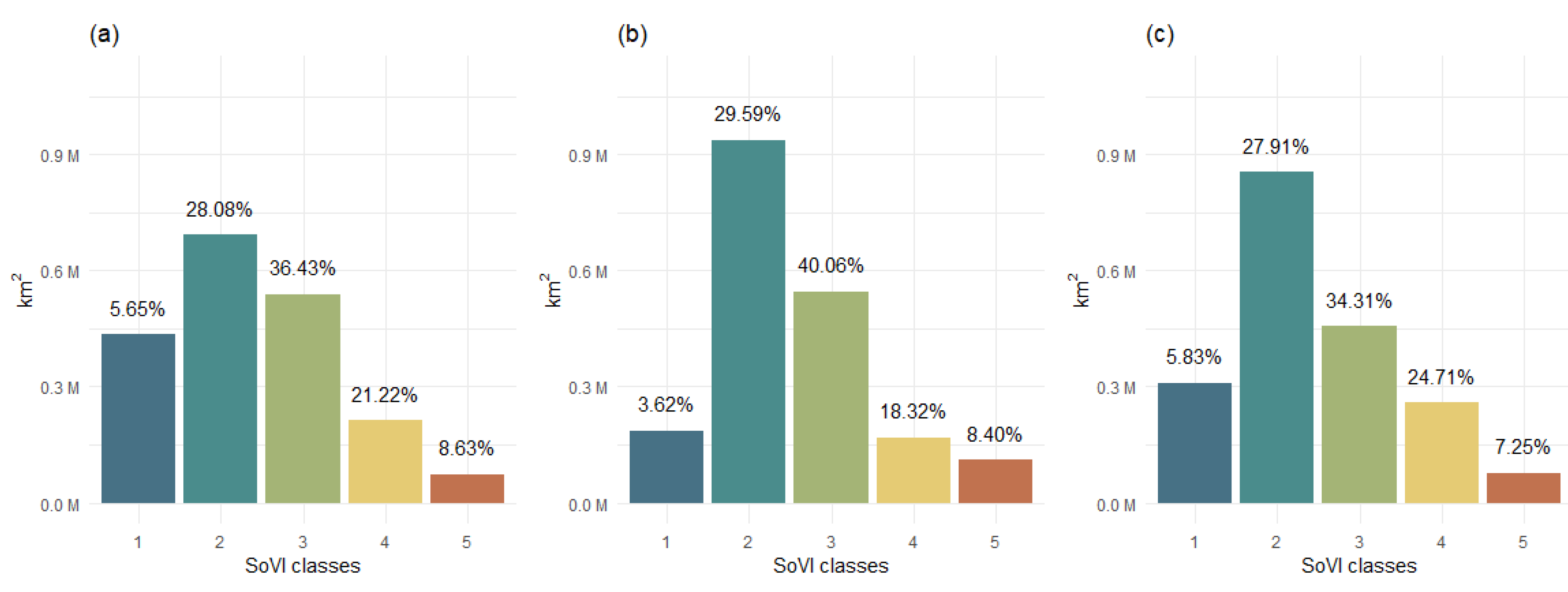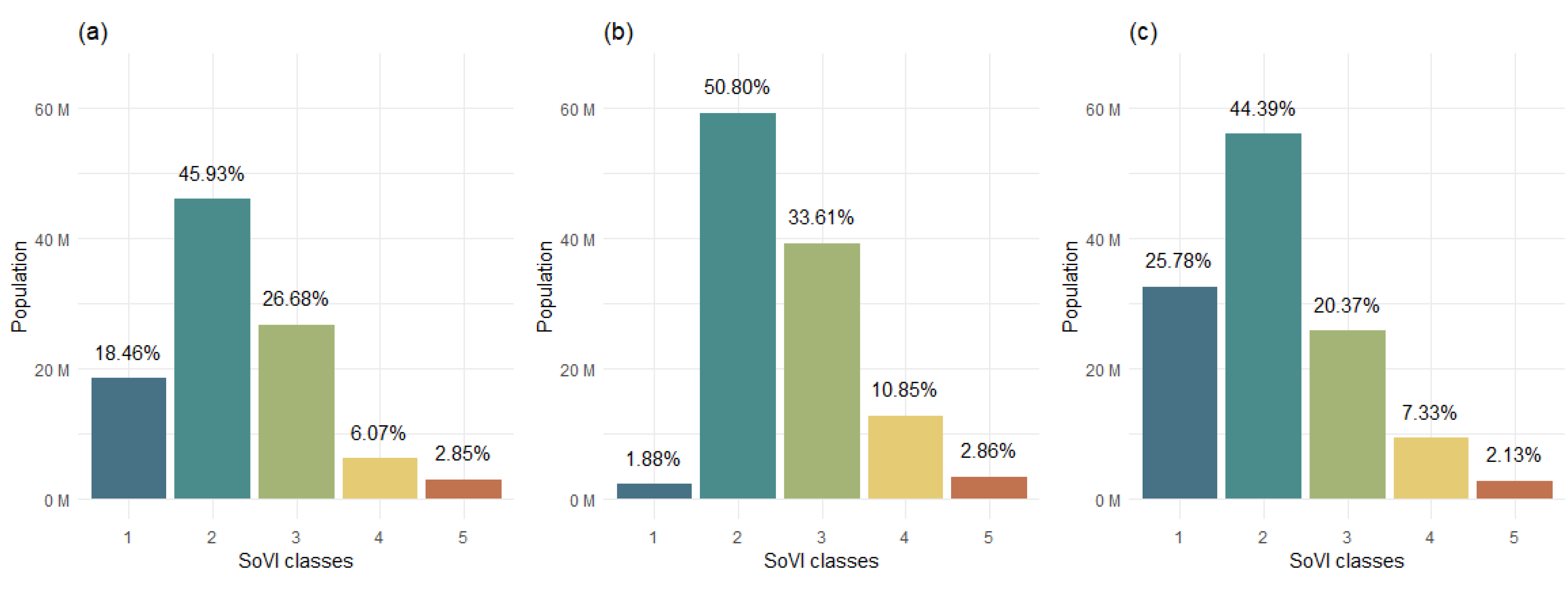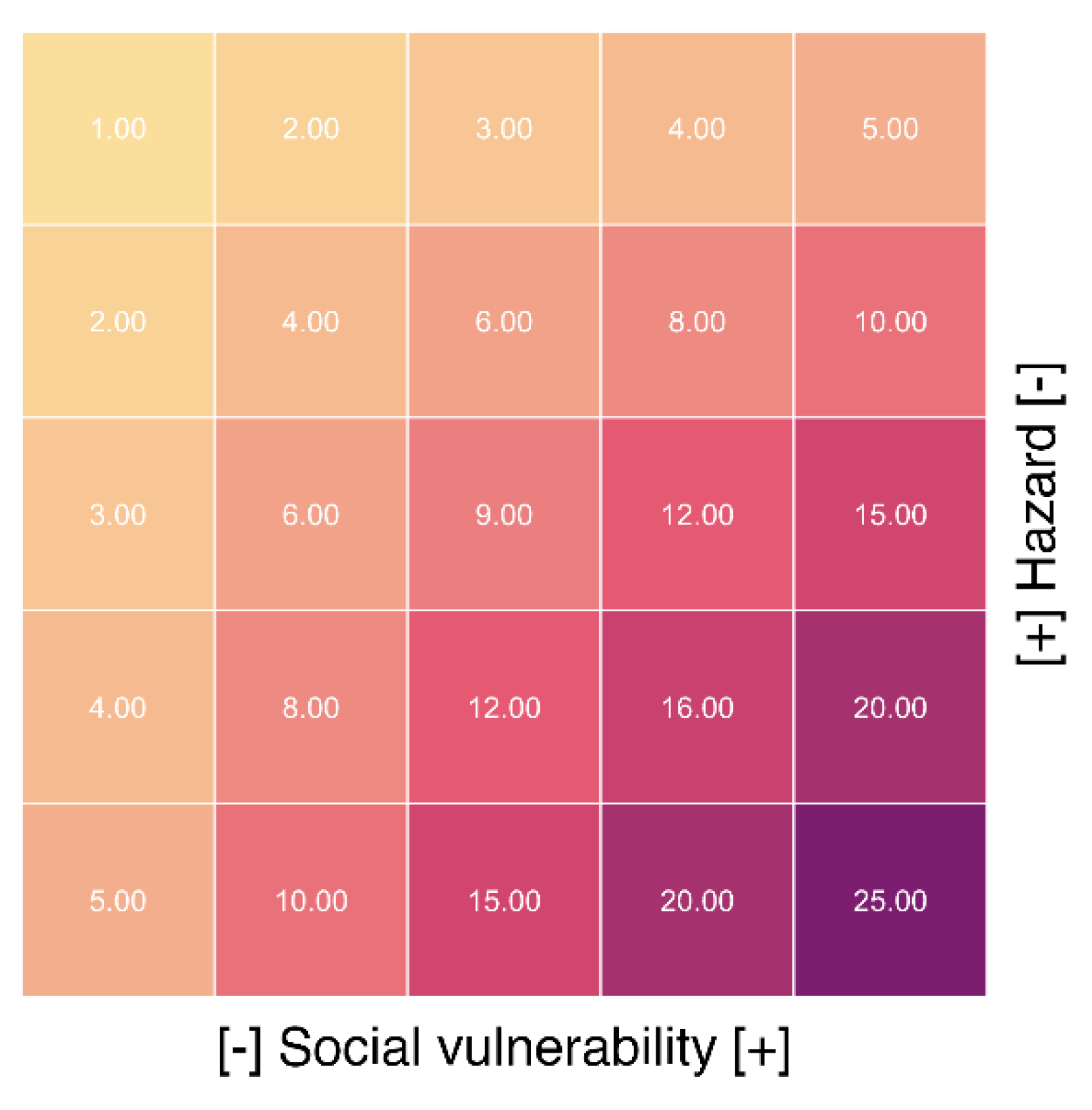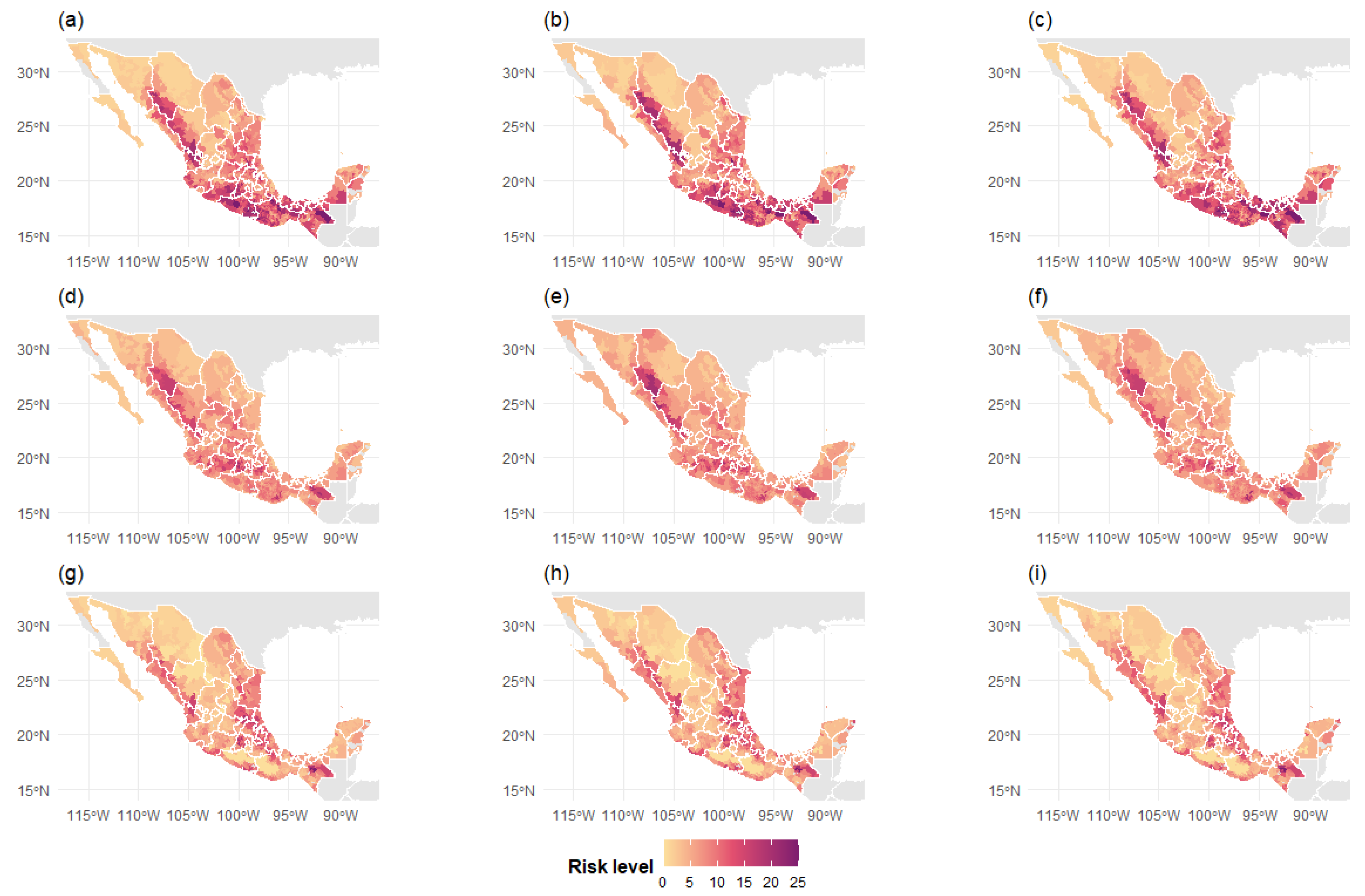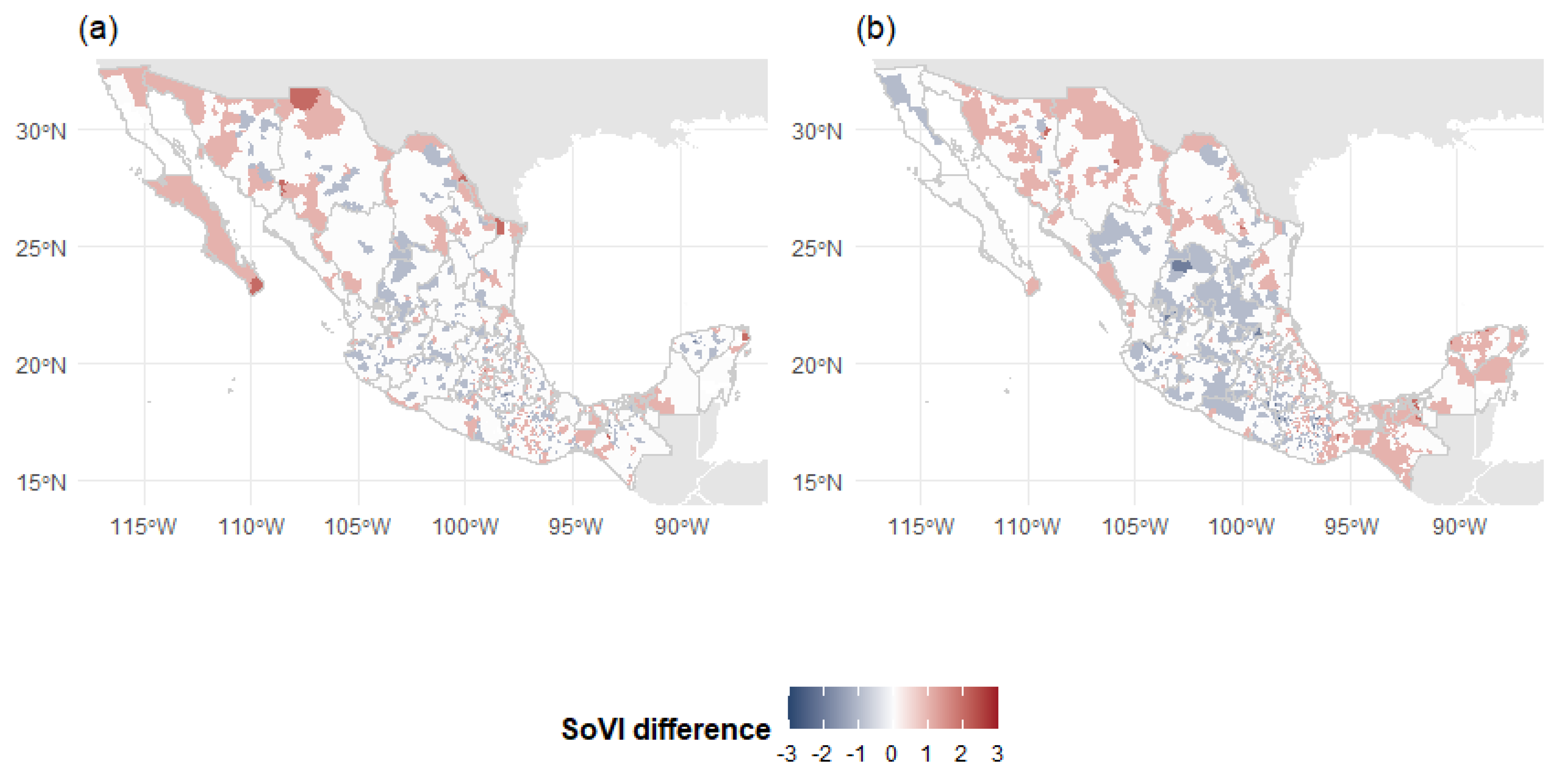1. Introduction
In recent years, the economic cost of disasters related to natural hazards has increased worldwide [
1]. Some estimations on the impacts of disasters show that in the last decade, around USD 170 billion in losses, with peaks over USD 300 billion, were reported globally every year [
2]. In Mexico, disasters triggered by natural hazards (2000–2018) caused around USD 26 million in losses, in addition to 17.7 million people affected and 22,000 people dying in the period 1900–2018 [
3]. Such increases in the economic cost of disasters have been mainly attributed to population and economic growth in disaster-prone areas, where both developed and developing countries have shown adverse effects [
4]. The weather phenomena are particularly interesting among the various natural hazards prone to trigger disasters, first, because of their high dominance in terms of occurrence and damages associated [
5], but also for the projected impact of climate change on its frequency and intensity [
6].
It is important to note that the mere occurrence of a natural phenomenon does not imply disaster materialization; instead, it must be combined with a series of pre-existing vulnerability conditions. The vulnerability concept has been studied from a wide variety of perspectives, but generally, it is understood as the characteristics of the population and their situation that influence their capacity to anticipate, cope with, resist, and recover from the impact of a natural (or anthropogenic) hazard [
7]. This concept can be explained based on progression factors divided into three levels: root causes, such as social and economic structures, culture, and ideologies; the dynamic pressures as societal deficiencies and other macro-forces; and, finally, the fragile livelihoods and unsafe situations, such as those related to natural, physical, human, political, and economical resources [
7,
8,
9]. Additionally, vulnerability is considered a multidimensional concept that includes cumulative and cascade processes [
10]. All these characteristics make it an extremely complex risk factor to analyze and, above all, to quantify.
Increasing knowledge of determining risk-driving factors is fundamental because of its potential application for generating public policies focused on disaster risk reduction. In this regard, previous research considers vulnerability assessment a requirement for efficiently developing emergency management capabilities and effective risk management [
7,
11]. To this end, several approaches to assessing vulnerability have been developed, which the Social Vulnerability Index (SoVI) proposed several years ago [
12] highlights. Such an approach involves applying a multivariate statistical method to a large set of socioeconomic and demographic variables to identify the vulnerability driving factors. The SoVI has been used, for example, in the Philippines [
13], Morocco [
14], Brazil [
15], Portugal [
16], and China [
17]. Other approaches using alternative weighted indices were recently implemented in Italy [
18] and Indonesia [
19].
In addition to the SoVI computation, the Geographical Information Systems (GIS) allows mapping of the resulting indices, which is helpful not only to identify the root causes of vulnerability (or their changes over time) but also the location (or changes) of the vulnerable population. In this regard, some studies have been focused on the uses of a GIS-based approach to identify the distribution of social vulnerability along specific sites such as rivers or coastal zones [
20,
21], but also their variability at local [
22], regional [
23], and national [
18] levels. The development of a GIS-based approach has permitted the identification of critical regions that are highly vulnerable, but also their spatial patterns by clustering social vulnerability, for example, using spatial autocorrelation techniques [
24]. In summary, the results from the available literature show that the SoVI methodology, accompanied by mapping the results, is an effective tool for disaster risk reduction [
25].
Given the nature of the vulnerability, which is not a static parameter, its evaluation requires systematic updating. In this sense, diverse investigations have been conducted to examine the changes in the vulnerability, either to visualize spatial differences, changes in the driving factors, or both. For example, prior research in China shows a gathering–scattering–gathering pattern of social vulnerability over time, where rural, development, and economic characteristics were the main driving vulnerability factors [
26]. Other studies in the U.S. have shown how the vulnerability driving forces vary spatial and temporally, attributable to components such as increasing development and diversity [
27]. Similar findings were in Italy, where, besides examining changes in vulnerability driving factors, a bivariate spatial correlation analysis was used to investigate the spatial relationship of social vulnerability over time [
24].
In Mexico, the spatial analysis of vulnerability to natural hazards has been carried out from diverse approaches. For example, a recent methodology to calculate drought vulnerability (one of the most significant threats in the country) using socioeconomic and environmental indicators has been presented [
28]. Likewise, a climate change vulnerability index in agriculture using a multidimensional approach to vulnerability (i.e., through the computation of exposure, sensitivity, and adaptative capacity) has been published using a series of indicators and historical and future-climate data [
29]. The vulnerability to intense rainfall using land cover and use changes, terrain slope, and basin compactness has also been assessed [
30]. More recently, a social vulnerability index to tornadoes has been constructed through a multivariate statistical method and socioeconomic indicators [
31]. Moreover, a multitemporal assessment of vulnerability to climate change in the agricultural sector using a large set of environmental, demographic, and agricultural indicators has been carried out [
32].
Despite the progress shown in Mexico regarding the evaluation of vulnerability, to date, no investigation has focused on the multi-temporal assessment of social vulnerability to natural hazards at the national level. To fill this gap, this research used census data from the last decades to generate vulnerability indices based on the SoVI methodology. Subsequently, temporal and spatial comparations were made using a Geographical Information Systems (GIS)-based approach. Furthermore, a severe weather risk assessment was conducted using diverse hazard indices for thunderstorms, hailstorms, and tornadoes. The paper’s organization is as follows.
Section 2 presents the study area, and
Section 3 displays the data and methods.
Section 4 shows the results based on the distribution of the different vulnerability levels computed. Then,
Section 5 discusses the major characteristics and their root causes of the spatial and temporal changes in social vulnerability in Mexico. Finally, conclusions are presented in
Section 6.
3. Materials and Methods
The input data were obtained from the latest three Mexican national censuses: 2000, 2010, and 2020 [
33]. The spatial analysis unit selected was the municipality because it represents the smallest administration unit responsible for risk and disaster management at the local level [
31]. It is important to note that several changes in some municipality limits were observed across the years but did not impact the calculations performed. An initial set of 22 variables related to vulnerability was selected based on previous research [
12,
16,
19,
24] with the corresponding adaptations given the Mexican context. The lack of uniformity of data from the censuses limited the use of a more extensive set of variables. For example, in the 2000 census, 132 variables were available, significantly differing from the 200 and 286 variables present in the 2010 and 2020 censuses, respectively. Then, multicollinearity analyses were performed on the initial variables set, and 18 were retained (
Table 1).
The selected variables were standardized using z-scores because of their unit’s heterogeneity. Then, Kaiser–Mayer–Olkin (KMO) and Bartlett tests were performed to evaluate the factor analysis applicability. KMO showed values of 0.87 (2000), 0.84 (2010), and 0.83 (2020) with
p-values < 0.001 in all the cases, proving the feasibility of the selected technique. Subsequently, the factor analyses were carried out using the principal components technique, the varimax rotation, and the Kaiser normalization, as in previous studies [
18,
19,
26]. Finally, factors with eigenvalues greater than one were extracted (
Figure 1).
Four, four, and five factors were extracted for the 2000, 2010, and 2020 datasets, which explained 66.8%, 64.3%, and 67.7% of the total variance, respectively. The variance explained by the factors in this research is consistent with various previous studies (e.g., [
15,
26]). Then, equal-weighted indices were constructed according to the original SoVI methodology [
12]. The resulting SoVI values were categorized from one to five based on the standard deviation classification method and were integrated into the correspondence municipality units for spatial analysis. In this respect, 2443, 2456, and 2469 spatial units were used for 2000, 2010, and 2020, respectively. A summary of the methodology followed is shown in
Figure 2.
4. Results
4.1. Changes in Vulnerability Driving Factors
In 2000, four components that (please see
supplementary materials, Figure S1), in conjunction, explain the 66.8% of variance were defined. The first component (F1) was labeled as education, ethnicity, infrastructure, and socioeconomic, explaining 34.7% of the variance. The second component (F2) was labeled as anthropization and employment, holding 11.1% of the proportion variance. The third component (F3) was defined as age, mobility, and overcrowding, with a 10.8% proportion variance, and, finally, the fourth component (F4) was gender, with a 10.2% explained variance. For this year, there exists a clear separation between the first and the rest of the components, which indicates the great weight that the variables that compose it have for social vulnerability.
Ten years later, in 2010, four components were maintained in the SoVI analysis (please see
supplementary materials, Figure S2), but the explained variance decreased to 64.3%. The first component (F1) was labeled as education, infrastructure, and socioeconomic, with a proportion variance of 27.5%. In second place, (F2) was defined the component labeled as age, mobility, and overcrowding with 13.1% explained variance. The next component (F3) was labeled as anthropization and migration with a proportion variance of 12%, while the fourth component (F4) was the same as the previous case, gender, with 11.7% of the explained variance. This year, the difference between the first component and the rest decreased significantly but still differentiates the weight of variables such as illiteracy, the characteristics of the houses, and the assets they hold in the social vulnerability.
Finally, in 2020, the number of components increased to five (please see
supplementary materials, Figure S3), and the total variance explained reached 67.7%. In this year, the first factor (F1) was labeled (same as in 2000) as education, ethnicity, infrastructure, and socioeconomic, explaining 25.10% of the variance. The second factor (F2) was defined as age but also contained a variable from the infrastructure concept, with a proportion variance of 12.7%. The third factor (F3) was defined as anthropization with a 10.6% proportion variance and, as in the previous case, also contains a variable from the socioeconomic concept. The fourth (F4) and fifth factors (F5) were labeled as overcrowding and mobility, and gender and health, which explained the 10.3% and 8.9% of the variance, respectively. It is important to note that, in 2020, the differences between the first and the rest of the factors were the smallest, indicating a more uniform distribution among the factors related to social vulnerability.
Interestingly, the first component is almost the same for the analyzed decades, containing variables from education, infrastructure, socioeconomic, and, in two cases, ethnicity concepts. The anthropization is also present in the 3 analyzed years in different positions: two times as part of F2 and one time as F3, accompanying other concepts with a single appearance, employment (in 2000), and migration (in 2010). The age, mobility, and overcrowding concepts compose the F2 and F3 for 2000 and 2010 and still appear in 2020 as F4 without the age concept. Finally, gender concept is a common factor in the analyzed decades, as the last factor of each year, with the particularity of it being accompanied by the health concept in 2020. The slight variations in the composition of the factors and the relative weights, explained by the proportion variance, indicate that the vulnerability driving factors in Mexico have suffered minor changes since 2000. In the discussion section, some possible explanations for this behavior are detailed.
4.2. Spatial and Temporal Changes in SoVI
The spatial distribution of social vulnerability in Mexico is shown in
Figure 3. The results indicate some spatial changes in the last 20 years, except for some specific regions. In this sense, three well-defined hotspots of municipalities classified with very high social vulnerability are in the northwestern, central-west, and southern Mexican territories. Such areas showed consistent behavior from 2000 to 2020, with minimal variations (principally in the northwestern hotspot). Interestingly, these areas coincide with important mountain ranges: the north and south portions of the Western Sierra Madre, the Southern Sierra Madre, and the Chiapas Highlands, which may be associated with areas of difficult access and minimal or non-existent public infrastructure. Furthermore, these regions have been historically linked with marginalized municipalities housing indigenous populations. The inherent isolation of these geographic centers makes it challenging to provide infrastructure and basic services, as well as hindering the swift deployment of emergency services and adequate recovery efforts following a disaster.
On the other hand, low and very low social vulnerability classes are observed in the north and central portions of the country, as well as in Mexico City (the capital) and surrounding areas. Such behavior is consistent in the three analyzed decades. Interestingly, the very low SoVI classes seem to have undergone a process of rupture and segregation from 2000 to 2020, concentrating on particular areas, such as the Baja California Peninsula and the border with the United States (U.S.), in the northern part of the country. A small cluster with very low SoVI classes in central Mexico is also visible. This area coincides with the capital and the Metropolitan Zone of the Valley of Mexico, where significant economic and urban development exists. Finally, other extensive areas with low and very low social vulnerability are depicted in the country’s central–western portion and the Pacific Ocean’s lowlands in front of the Baja California Peninsula. Such areas are essential agricultural production clusters and coincide with one of Mexico’s biggest and most economically important cities, Guadalajara, Jalisco.
The municipalities classified with medium and high SoVI classes surround those regions with very high vulnerability classes. Except for specific regions, no significant changes were observed in the spatial distribution of these classes from 2000 to 2020. In this sense, it can be mentioned that the Yucatan Peninsula transitions from low and medium-to-high SoVI classes. The same pattern but from medium and high to very high is depicted in the southeastern part of the country, over the Chiapas Highlands. The results show that the spatial distribution of diverse classes of social vulnerability to natural hazards in Mexico has not suffered critical changes in the last decades; in this sense, the highest vulnerable regions have been the same since the beginning of the millennium.
In terms of territorial extensions in km
2 and the percentage of municipalities associated (
Figure 4), the territory with low SoVI class showed a consistent predominance in the three analyzed decades, with variations from 28.08% of municipalities in 2000 to 29.59% in 2010 and 27.91% in 2020. In the lower extreme (i.e., very low social vulnerability class), there are interesting changes with a severe decrease in the 2000–2010 period in terms of territorial extension (around 0.25 million km
2) but not too large in the percentage of municipalities (derived from a transition from very low to low SoVI in municipalities with large territorial extensions). The high SoVI class suffered changes ranging from around 0.21 million km
2 (21.22% of municipalities) in 2000 to 0.15 million km
2 (18.32% of municipalities) and 0.25 million km
2 (24.71% of municipalities) in 2020. There are no critical changes in the very low and medium social vulnerability classes, which vary around 1% (around 0.03 million km
2) and 4% maximum (around 0.09 million km
2), respectively.
The total population exposed to different SoVI classes and their percentage are shown in
Figure 5. The majority of the Mexican population showed low social vulnerability in the three analyzed decades: 45.93% in 2000, 50% in 2010, and 44.39 in 2020. On the contrary, the lowest proportion is observed in the very high vulnerability class, with minimal variations from 2.85% in 2000, 2.86% in 2010, and 2.13% in 2020. The percentage of the population in the medium SoVI class is 26.68% (in 2000), 33.61% (in 2010), and 20.37% (in 2020). The high SoVI class suffers minimum changes over time, with 6.07%, 10.85%, and 7.33% for 200, 2010, and 2020, respectively. The population classified in the very low SoVI shows the most significant changes, decreasing more than 16% from 2000 to 2010 and increasing around 24% from 2010 to 2020.
The population and territorial extension changes for each SoVI class show two different and well-defined patterns. For the period 2000–2010, where a population increase was observed (around 16 million people), there was also an increase in the low, medium, and high SoVI classes, as well as a decrease in the very low SoVI class. Such changes involve around 16 million people. In the upper end (i.e., very high SoVI class), a minimal variation exists in this period, which is an increase of around 0.5 million people. The changes in territorial extensions follow the same pattern. In this sense, the increase observed in the low SoVI class (and the decrease in the very low SoVI class) is explained by the change in category in municipalities with large territorial extensions in the northwest, particularly in the Baja California Peninsula. This behavior also supports the increased number of people, given the change from very low to low SoVI class of one of the densest populated cities in Mexico: Tijuana, Baja California, which is on the border with the U.S.
The second pattern is from 2010–2020, while the population is still growing (around 9.6 million people in 10 years). In this period, the population in the low, medium, and high SoVI classes showed a critical decrease (behavior contrary to the previous period), and the very low class increased significantly. The upper end also shows a change, with a shallow decrease. The change in territorial extensions follows this same pattern. In this period, the Baja California Peninsula changes (from low to very low SoVI class) strongly affect territorial extension changes. Also in this period, the separation between very low and low SoVI classes from the rest becomes much more evident.
4.3. Severe Weather Risk Assessment
Using the previous SoVI computations, a severe weather risk assessment in the study area was performed. Among the different convective hazards associated with severe weather, thunderstorms, hailstorms, and tornadoes are three of the principal ones. The three above-mentioned meteorological hazards are related to convective storms, natural phenomena with generally quick development and minimal predictability. In countries like Mexico, where there is a lack of meteorological instrumentation (e.g., weather radars), monitoring and nowcasting are a real challenge.
In this sense, diverse investigations have pointed out the country’s dangers and impacts of these convective hazards. For example, it is estimated that there were over 7300 lighting stroke-related deaths in 1979–2011 [
35]. On the other hand, it is approximated that around 72% of tornado events in Mexico (in the period 2000–2012) caused some damage [
36], highlighting significant tornadoes such as that occurred in Cd. Acuña, Coahuila, (in northern Mexico) in 2015 that caused around 14 deaths [
37]. In the case of hailstorms, despite the fact that there is not an official database in Mexico on their associated damage, previous research mentioned that this convective hazard affects more than 50 million people, especially in municipalities with intensified agricultural activities [
32].
In this context, the Thunderstorm Risk Index (ThRI), Hailstorm Risk Index (HaRI), and Tornado Risk Index (ToRI) were computed as the product of the Social Vulnerability Index (SoVI), and the Thunderstorm (ThHI), Hailstorm (HaHI), and Tornado (ToHI) hazard indices. Since large datasets on these phenomena are unavailable to Mexico, the ThHI, HaHI, and ToHI were considered static parameters. The ThHI was obtained from the CENAPRED [
38] and constructed using in situ observations and lighting data. The HaHI was obtained from the same national agency [
39] but only considers in situ observations. Finally, the ToHI was provided by previous research [
31], and it was made by combining historical tornado reports and reanalysis data. Then, the risk index for each hazard was computed using a 2D matrix approach (
Figure 6).
In the computed values for the case of thunderstorms (
Figure 7), the risky areas are located in the northwest and south portions of the country in the 3 analyzed years. These risky areas coincide with principal mountain ranges such as the Western, Eastern, and Southern Sierras Madres. Interestingly, the ThHI and SoVI hotspots with high values also coincide, resulting in areas proper to societal impacts from thunderstorms. Such impacts can be related to lightning strikes, floods from heavy rainfall events, or indirect effects such as landslides. Given that thunderstorms associated with tropical cyclones are also included in the ThRI, some regions in the Yucatan Peninsula also show a high risk of this natural phenomenon.
A similar spatial pattern follows the hailstorm risk. However, for this convective hazard, the higher values are concentrated in less extended areas (i.e., specific municipalities), principally in northwest and central Mexico. These areas also coincide with higher elevations and particular mountain ranges, such as the Trans-Mexican Volcanic Belt (TMVB), the Western Sierra Madre, and the Sierra of Chiapas. For this convective hazard, municipalities with large extensions of agricultural activities are the principal affected. In this sense, some of these areas with high SoVI values are found on the north coasts of the Pacific Ocean.
Finally, the ToRI identifies several important hotspots in the northwest coastal plains and the northeast. In these regions, significant tornadoes have impacted in recent years, with substantial socioeconomic impacts associated; however, the computed risk values are intermediate. The above explains the medium-low SoVI values prevalent in these areas. On the other hand, along the TMVB, high-risk values are identified, principally at the central-east portion, which is related to a high incidence of tornadoes and intermediate-high SoVI classes. Likewise, the Pacific coasts and the Yucatan Peninsula show high-risk values, given the high SoVI values and the recurrent generation of waterspouts.
As the SoVI changes, risk changes over the three decades do not show significant variability. The proportion of municipalities in each risk category is quite similar, with a little increase in 2010. This increase is more evident in the northwest territory for thunderstorms and hail but is not visible for tornadoes (
Figure 7). In this last one, the most remarkable changes are observed in the northeast border with the U.S. and the east portion of the TMVB. It is important to note that, generally, higher severe weather risk zones are the same for the three convective hazards. Likewise, the areas with lower risk values are always the central-north portion of the territory and the Baja California Peninsula. Although severe weather events are not commonly documented here, it is one of the zones where tropical cyclones make landfall in the greatest proportion [
40].
5. Discussion
Derived from the SoVI computations, diverse common vulnerability driving factors are identified with the highest importance in the 3 analyzed years. Such factors include education, ethnicity, socioeconomic, and infrastructural variables. Other similar studies have mentioned them as common factors related to vulnerability (e.g., 12, 16–19, 24). Regarding the role of education in social vulnerability, some authors have related this parameter to constraints in understanding warning information and access to recovery actions [
12]. The variable used in this study for the education concept is illiterate, which, in addition to the previously mentioned impacts, could affect vulnerability by limiting the possibility of accessing a better-paid job and favoring situations of poverty. In Mexico, literacy campaigns began with the creation of the Secretary of Public Education in the 1920s [
41], and, in recent times, the percentage of the illiterate population at the national level has decreased from around 25.8% in 1970 and 9.5% in 2000 to only 4.7% in 2020 [
42]. Despite these significant reductions in the population without primary education, some remnants have been dragging on for years in this subject, particularly in the country’s southern states. The impact of illiteracy, which is confined to very particular regions of Mexico, is such that, despite the campaigns already mentioned, it continues to stand out as a primary factor associated with vulnerability.
Similar behavior can be mentioned for infrastructure and socioeconomic concepts, the other two constants in the primary vulnerability driving factors observed in Mexico from 2000 to 2020. Both are related to marginalization and poverty, which can be understood as the socioeconomic, political, or cultural exclusion of the population in front of the dominant system and a low-income situation leading to underconsumption. In this sense, the previous literature has extensively discussed their relationships with social vulnerability [
43,
44]. In this research, such concepts include variables such as access to public services (e.g., drinking water or electricity) and diverse assets (e.g., vehicle or telephone). Similar to what happens with education, poverty has suffered changes with a generally decreased trend in the last decades [
45], and marginalization has also shown a generalized decrease but persistence of a gap between the south and the rest of the country [
46].
Finally, ethnicity is another common primary vulnerability driving factor in two of the three analyzed decades. This concept is understood as the percentage of the indigenous population, and recent research found a significant relationship between these groups and high-vulnerable regions to extreme meteorological phenomena [
31]. Some determinants of the increasing vulnerability in these minority groups are their localization in rural areas (which makes it challenging to access essential services), the economic disparities compared with the non-indigenous population, the access to education and health services, and their historical land dispossessions [
47]. These ethnic inequalities have been historical and structural, rooted in the socio-economic disparities arising from the geographical and ethnic origins of the population within the country. Hence, it is also referred to as an ethnic structural gap [
48]. These situations have caused a persistent inequity for indigenous peoples in Mexico, an issue widely discussed in the literature in the national context (e.g., [
49,
50]).
As can be observed, the most significant percentage of crucial social vulnerability driving factors tends to be reduced, given the government’s generation and implementation of support programs. However, these concepts continue to have a major influence on SoVI computations. In this regard, vertical structural gaps in productivity and innovation, poverty, and infrastructure have been documented, negatively impacting the Mexican population, particularly those in rural areas, although urban areas have also been affected to a lesser extent. Furthermore, these structural gaps manifest differentially across the various regions of the Mexican Republic [
48]. It can be hypothesized that there are root causes related to vulnerability, which the programs mentioned above have not addressed. Changes in crucial government positions and the lack of continuity (i.e., they are intended for immediate impact only) in generated programs could be some of the main reasons. Likewise, relationships exist between the variables that can cause cumulative and feedback effects, highlighting vulnerability situations. The above-mentioned seems particularly important to minority groups, for example, the indigenous population in Mexico.
The mentioned associations are evidenced by minimal changes observed in the spatial distribution of municipalities classified with high and very high social vulnerability from 2000 to 2020. In this sense, the relation between these areas with the location of the highest marginalized population [
51] and indigenous population [
52] is clear. Some examples of this are visible in the location of indigenous groups in the northwest (e.g., Tarahumaras), the central-west region (e.g., Coras and Huicholes), and the southern regions (e.g., Zapotecos, Mixtecos, and Tzotziles). Additionally, the location of these groups, and generally, of the most marginalized municipalities, also coincides with important mountain ranges, such as the north and south portions of the Western Sierra Madre, the Southern Sierra Madre, and the Sierra of Chiapas (in the southeast). As previously mentioned, the isolation of these areas can be associated with increasing vulnerability, given the difficulty that faces the emergency services in accessing these regions, but also for effective communication in the face of potential threats.
Starting from the consideration that disasters and risk stem from social processes that generate conditions of vulnerability, it is essential to examine the impact of the neoliberal political–economic project on the lives of the Mexican population. Some analysts suggest that the economic outcomes have been insufficient for six presidential terms after the Mexican economy became a laboratory for neoliberal experimentation by implementing structural reforms and economic disciplines recommended by international financial institutions. The neoliberal strategy has brought about increased income inequality and a severe decline in the well-being of the vast majority of Mexicans [
53]. While structural conditions of inequality and poverty predate neoliberalism, various studies highlight the connection between neoliberalism and social vulnerability. The above is because the spatiality of neoliberalism, its global reach, and local manifestations synthesize the roles of the state and the market in the economy and their repercussions on the living conditions of society members. This configuration shapes expressions of vulnerability in the population and the government’s role in safeguarding the population against disasters [
54].
Another determining factor of social vulnerability during the analyzed period has been gender. This factor is both pervasive and structural, as in Mexico, there is a higher proportion of women than men who lack their own income and have a lower rate of economic participation. This gap is even wider in rural areas compared to urban ones [
48]. In this regard, various studies from international organizations have promoted and advocated for a gender perspective in disasters, as well as the intersection of different forms of discrimination and gender-based violence that can affect women, girls, and adolescents with disabilities due to reasons of race, religion, class, sexual preference or identification, or others. These discriminations and violence contribute to conditions of social vulnerability (e.g., [
55,
56,
57]).
Although the computed indices do not consider a different weight between the factors that compose them, the variance explained by each factor varies from decade to decade. These changes, which can be majorly identified as reductions between the variances, are related to a decrease in the importance of one factor to the rest. This behavior has also been observed in other similar studies [
26]. In this research, the reductions observed between the first and the last factor obtained by the statistical analyses are associated with matching the different parameters related to social vulnerability. Other investigations have weighted the SoVI using the explained variances of each factor [
18,
19], with which it is intended to position the differences between the factors. This research shows that even without considering the differences between factors in the SoVI computations, it is possible to observe their impact, minimaxing the influence of any factor on another. The above is spatially important given that there is no consensus about which parameters are most important to social vulnerability.
Generally, the spatial changes of SoVI in Mexico (
Figure 8) could be classified into those areas with a constant social vulnerability increase, those with a continuous decrease, and other municipalities with no change. Concerning the municipalities with constant social vulnerability increase, it is noteworthy to highlight the northwest and border municipalities with the U.S., the southeast, and the Yucatan Peninsula (
Figure 8). The greatest changes in the border with the U.S. could be associated with migration processes (principally in the 2000–2010 period), coinciding with the social vulnerability driving factor found for 2010. In this sense, previous research mentioned that the increasing migration from Mexico–US stalled in the 2000s and turned to a zero net rate in 2010, derived from the economic crisis and deportations [
58]. The same pattern observed in the Yucatan Peninsula can be mainly linked to the migration of low-income workers to the outskirts of large tourist centers such as Cancun and Playa del Carmen [
23,
59]. Finally, for the southeast, this constant increase in SoVI values is probably related to a higher prevalence of poverty and economic inequality compared to other parts of the country, where a significant portion of the population lacks access to basic services, education, and healthcare [
60]. Calculating vulnerability from factor analysis for each year independently thus allows highlighting the growth of the social gap between areas of constant low vulnerability and areas where it was not possible to reduce.
The municipalities with a constant decrease in SoVI values are observed mainly in the central portion of the country (
Figure 8). Likewise, such behavior is similar in the country’s capital and surrounding areas. Such municipalities change (in general terms) from medium SoVI classes to low and very low ones. The decreasing patterns are likely related to increased economic and industrial development in recent years. For example, some studies have mentioned that foreign direct investment in The Bajio region in central Mexico (including San Luis Potosí, Guanajuato, Querétaro, and Aguascalientes states) affected the economic-social development of the region [
61]. Likewise, the constant urban development in the surrounding areas of the Mexican capital has also impacted the observed decrease in the SoVI computed values; however, it is important to note that such urbanization processes can adversely affect environmental vulnerability [
30]. Finally, given that such areas of the country comprise a great percentage of the population, such spatial changes are reflected in the increase in population with low and very low social vulnerability to natural hazards in Mexico.
The municipalities without SoVI changes can highlight those holding very high classes, principally in the southeast side and the hotspot south of the Western Sierra Madre. This manuscript has widely discussed the reasons for the permanence of these municipalities with very high social vulnerability. In this sense, the root causes still need to be addressed appropriately to generate a decreasing effect on these communities’ vulnerability to natural hazards. Other regions without changes are located in the municipalities classified as low, medium, and high social vulnerability. The above coincides with the previously mentioned increased gap between very high and very low socially vulnerable regions in Mexico. In this sense, recent research has focused on the impact of rising economic inequality and its influence on social vulnerability to natural hazards [
62]. The results of this research provide some evidence of what could be called the social vulnerability gap in the Mexican context.
Concerning the changes in severe weather risk, the results indicate a convergence between municipalities classified with high hazard levels and high SoVI classes. The above is particularly clear for thunderstorms in the hotspots of very high SoVI classes. In these areas, not only are direct effects of thunderstorms possible but indirect effects such as landslides could also be expected due to the prevalent topography. Previous studies [
63] have provided landslide inventories coincident with the thunderstorm risk here defined (particularly over the southeastern region). In the case of hailstorm risk, the spatial pattern is similar but markedly different, mainly over the high altitudes of central Mexico. For tornadoes, a recently introduced hazard in the Mexican literature, the highest risk values are over the plains of the Pacific Ocean and along the coast of the Gulf of Mexico, but also in the highlands of the south and central part of the country. In this sense, some previous investigations have described important societal impacts derived from tornadoes in the mentioned areas [
64,
65,
66].
It is important to note that, despite the hazard component being considered a static element in these computations (due to the data limitations), future studies should focus on generating evolving hazard indices to complement the changing nature of risk. In this sense, generating confident, updated, and official databases on severe weather is crucial.
